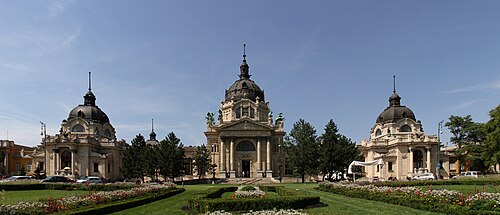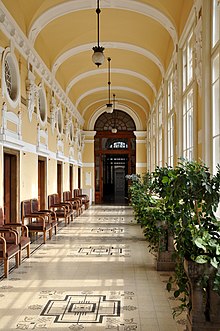Széchenyi Spa
The Széchenyi Spa ( Hungarian : Széchenyi gyógyfürdő ) is a spa in the Hungarian capital Budapest . The system is in the city park . The size of the bathroom makes it the largest of its kind in Europe. It was named after the statesman Count István Széchenyi .
history
The beginnings of the Artesian bath
Vilmos Zsigmondy addressed a petition to the Pest City Council on November 24, 1866 , in which he expressed his conviction that “in Pest, artesian wells can be extracted with the greatest probability of success , the water of which can be nothing but thermal water. “On March 3, 1868, the contract for the works in connection with the artesian well in the city park was finally signed. Ultimately, drilling began on November 15, 1868 and did not end until January 1878 at a depth of 970.48 meters.
The Budapest Public Works Council approved the construction of a bathhouse on Palatine Island on July 1, 1880. The bathhouse was opened just a year later. The cost was 28,485 forints and 57 krajcár . As the popularity of the bath grew more and more, in 1899 the company began to expand it. From 1904, the bath was allowed to use the title Heilbad . In 1907, the Artesian bath no longer met the requirements and the capital decided to build a new bath. The Artesian Bath building was demolished in 1936.
New construction and extensions
The cost of building the new pool was estimated at 3,835,100 corona . Construction began on May 7, 1909 and lasted until June 16, 1913. The building was divided into five baths:
- Private baths
- Steam baths for men
- Steam baths for women
- Volksbad for men
- Volksbad for women
A vestibule leads from the main entrance in the main building to the domed hall, which was designed as a traffic hub in the building. It has been designed most ornately as a representation room. The total built-up area including the heating and machine house was 75,294.34 square meters .
The depth of the artesian well is 960 meters. 760 cubic meters of the 73 ° C medicinal water gush out of the fountain every hour. The bathroom used around 475 cubic meters of this . While only 45 bathers could be received in the old Artesian bath, the Széchenyibad could now hold 421 bathers at the same time.
Since the bathing business caused losses, from 1924 thought was given to expanding the Széchenyibad. An outdoor swimming pool was to be built between the existing building and the road to the zoological garden on an area of 11,000 square meters. Furthermore, the public baths should be extended to the swimming pool. The new outdoor pool was opened on August 19, 1927. The water surface of the three large pools is 2,040 square meters. This outdoor pool now held an additional 3,400 bathers.
In 1935 the spa consisted of the following parts:
- Thermal bath for men - 4 pools, 151 changing rooms
- Thermal bath for women - 4 pools, 93 changing rooms
- 14 thermal salon baths
- 34 thermal baths, some of which are set up for mud, hot air, carbonic acid and electric baths and water healing treatments
- Machine Therapy (Zandr)
- Thermal public bath for men - 3 pools, 300 lockers
- Thermal public bath for women - 3 pools, 300 lockers
- Outdoor pool - 3 pools, 59 cabins, 1376 lockers
However, the expansion did not solve the problems of the bath's economy. The cost of heating the water burdened the budget with 45,000 to 46,000 pengő in 1935. Finally, the city approved the drilling of a second artesian well, which was successful on March 16, 1938 at a depth of 1,256 meters. The new Sankt-Stephan-Brunnen produced 6,000 cubic meters of hot water at 77 ° C every day. That was more water than originally estimated, so in 1939 the old heating system in the bathing building was converted to run on thermal water.
New beginning 1945
The Széchenyibad was only 20 percent damaged by the war ; the Sankt Stephan fountain was even left completely intact. After the rubble clearance had started on January 23, 1945, the outdoor pool was reopened on May 20 and the men's thermal baths and the two public baths were put into operation by the end of July. In 1949 a mud department was set up in the left wing of the bath, and in 1952 electrotherapy and a brine bath were added. The outdoor pool has been open all year round since November 26, 1963. However, the condition of the bath deteriorated noticeably in the second half of the 20th century. In 1998, a fundamental renovation began.
Bathroom equipment
Today the structure consists of three parts
- Spa
- swimming pool
- day clinic
The main entrance is on Kós Károly sétany and is decorated with columns and a tympanum . It lies in the main axis of the Czigler wing bordered by five domes. The main entrance to the swimming pool, flanked by columns, is opposite on the Állatkerti körút. It leads into a neo-baroque vestibule, in which the ticket offices are located on both sides. The day clinic can be reached from the northeast. The entrance in the southwest leads to the steam baths.
See also
literature
- Dr. Gábor Horváth, Dr. Péter Soós, Csaba Meskó, Imre Kiss and Dr. Remény Horváth: Széchenyi medicinal bath . Budapest Gyógfürdői és Hévizei Rt. (Budapest Spas and Thermal Springs AG), Budapest 2001, ISBN 963-00-6379-4 .
Web links
Coordinates: 47 ° 31 ′ 6.3 " N , 19 ° 4 ′ 56" E



